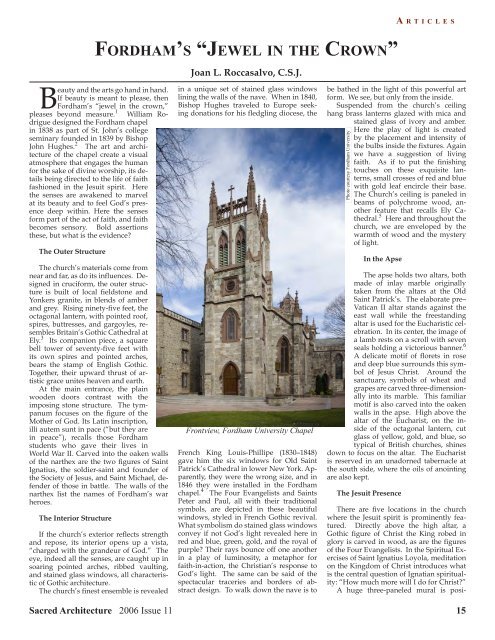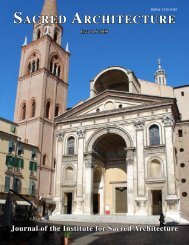Download Issue PDF - The Institute for Sacred Architecture
Download Issue PDF - The Institute for Sacred Architecture
Download Issue PDF - The Institute for Sacred Architecture
You also want an ePaper? Increase the reach of your titles
YUMPU automatically turns print PDFs into web optimized ePapers that Google loves.
FORDHAM’S “JEWEL IN THE CROWN”<br />
Beauty and the arts go hand in hand.<br />
If beauty is meant to please, then<br />
Fordham’s “jewel in the crown,”<br />
pleases beyond measure. 1 William Rodrigue<br />
designed the Fordham chapel<br />
in 1838 as part of St. John’s college<br />
seminary founded in 1839 by Bishop<br />
John Hughes. 2 <strong>The</strong> art and architecture<br />
of the chapel create a visual<br />
atmosphere that engages the human<br />
<strong>for</strong> the sake of divine worship, its details<br />
being directed to the life of faith<br />
fashioned in the Jesuit spirit. Here<br />
the senses are awakened to marvel<br />
at its beauty and to feel God’s presence<br />
deep within. Here the senses<br />
<strong>for</strong>m part of the act of faith, and faith<br />
becomes sensory. Bold assertions<br />
these, but what is the evidence?<br />
<strong>The</strong> Outer Structure<br />
<strong>The</strong> church’s materials come from<br />
near and far, as do its influences. Designed<br />
in cruci<strong>for</strong>m, the outer structure<br />
is built of local fieldstone and<br />
Yonkers granite, in blends of amber<br />
and grey. Rising ninety-five feet, the<br />
octagonal lantern, with pointed roof,<br />
spires, buttresses, and gargoyles, resembles<br />
Britain’s Gothic Cathedral at<br />
Ely. 3 Its companion piece, a square<br />
bell tower of seventy-five feet with<br />
its own spires and pointed arches,<br />
bears the stamp of English Gothic.<br />
Together, their upward thrust of artistic<br />
grace unites heaven and earth.<br />
At the main entrance, the plain<br />
wooden doors contrast with the<br />
imposing stone structure. <strong>The</strong> tympanum<br />
focuses on the figure of the<br />
Mother of God. Its Latin inscription,<br />
illi autem sunt in pace (“but they are<br />
in peace”), recalls those Fordham<br />
students who gave their lives in<br />
World War II. Carved into the oaken walls<br />
of the narthex are the two figures of Saint<br />
Ignatius, the soldier-saint and founder of<br />
the Society of Jesus, and Saint Michael, defender<br />
of those in battle. <strong>The</strong> walls of the<br />
narthex list the names of Fordham’s war<br />
heroes.<br />
<strong>The</strong> Interior Structure<br />
If the church’s exterior reflects strength<br />
and repose, its interior opens up a vista,<br />
“charged with the grandeur of God.” <strong>The</strong><br />
eye, indeed all the senses, are caught up in<br />
soaring pointed arches, ribbed vaulting,<br />
and stained glass windows, all characteristic<br />
of Gothic architecture.<br />
<strong>The</strong> church’s finest ensemble is revealed<br />
Joan L. Roccasalvo, C.S.J.<br />
in a unique set of stained glass windows<br />
lining the walls of the nave. When in 1840,<br />
Bishop Hughes traveled to Europe seeking<br />
donations <strong>for</strong> his fledgling diocese, the<br />
Frontview, Fordham University Chapel<br />
French King Louis-Phillipe (1830–1848)<br />
gave him the six windows <strong>for</strong> Old Saint<br />
Patrick’s Cathedral in lower New York. Apparently,<br />
they were the wrong size, and in<br />
1846 they were installed in the Fordham<br />
chapel. 4 <strong>The</strong> Four Evangelists and Saints<br />
Peter and Paul, all with their traditional<br />
symbols, are depicted in these beautiful<br />
windows, styled in French Gothic revival.<br />
What symbolism do stained glass windows<br />
convey if not God’s light revealed here in<br />
red and blue, green, gold, and the royal of<br />
purple? <strong>The</strong>ir rays bounce off one another<br />
in a play of luminosity, a metaphor <strong>for</strong><br />
faith-in-action, the Christian’s response to<br />
God’s light. <strong>The</strong> same can be said of the<br />
spectacular traceries and borders of abstract<br />
design. To walk down the nave is to<br />
<strong>Sacred</strong> <strong>Architecture</strong> 2006 <strong>Issue</strong> 11 15<br />
Photo courtesy Fordham University<br />
A R T I C L E S<br />
be bathed in the light of this powerful art<br />
<strong>for</strong>m. We see, but only from the inside.<br />
Suspended from the church’s ceiling<br />
hang brass lanterns glazed with mica and<br />
stained glass of ivory and amber.<br />
Here the play of light is created<br />
by the placement and intensity of<br />
the bulbs inside the fixtures. Again<br />
we have a suggestion of living<br />
faith. As if to put the finishing<br />
touches on these exquisite lanterns,<br />
small crosses of red and blue<br />
with gold leaf encircle their base.<br />
<strong>The</strong> Church’s ceiling is paneled in<br />
beams of polychrome wood, another<br />
feature that recalls Ely Cathedral.<br />
5 Here and throughout the<br />
church, we are enveloped by the<br />
warmth of wood and the mystery<br />
of light.<br />
In the Apse<br />
<strong>The</strong> apse holds two altars, both<br />
made of inlay marble originally<br />
taken from the altars at the Old<br />
Saint Patrick’s. <strong>The</strong> elaborate pre–<br />
Vatican II altar stands against the<br />
east wall while the freestanding<br />
altar is used <strong>for</strong> the Eucharistic celebration.<br />
In its center, the image of<br />
a lamb rests on a scroll with seven<br />
seals holding a victorious banner. 6<br />
A delicate motif of florets in rose<br />
and deep blue surrounds this symbol<br />
of Jesus Christ. Around the<br />
sanctuary, symbols of wheat and<br />
grapes are carved three-dimensionally<br />
into its marble. This familiar<br />
motif is also carved into the oaken<br />
walls in the apse. High above the<br />
altar of the Eucharist, on the inside<br />
of the octagonal lantern, cut<br />
glass of yellow, gold, and blue, so<br />
typical of British churches, shines<br />
down to focus on the altar. <strong>The</strong> Eucharist<br />
is reserved in an unadorned tabernacle at<br />
the south side, where the oils of anointing<br />
are also kept.<br />
<strong>The</strong> Jesuit Presence<br />
<strong>The</strong>re are five locations in the church<br />
where the Jesuit spirit is prominently featured.<br />
Directly above the high altar, a<br />
Gothic figure of Christ the King robed in<br />
glory is carved in wood, as are the figures<br />
of the Four Evangelists. In the Spiritual Exercises<br />
of Saint Ignatius Loyola, meditation<br />
on the Kingdom of Christ introduces what<br />
is the central question of Ignatian spirituality:<br />
“How much more will I do <strong>for</strong> Christ?”<br />
A huge three-paneled mural is posi-










